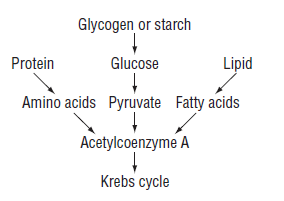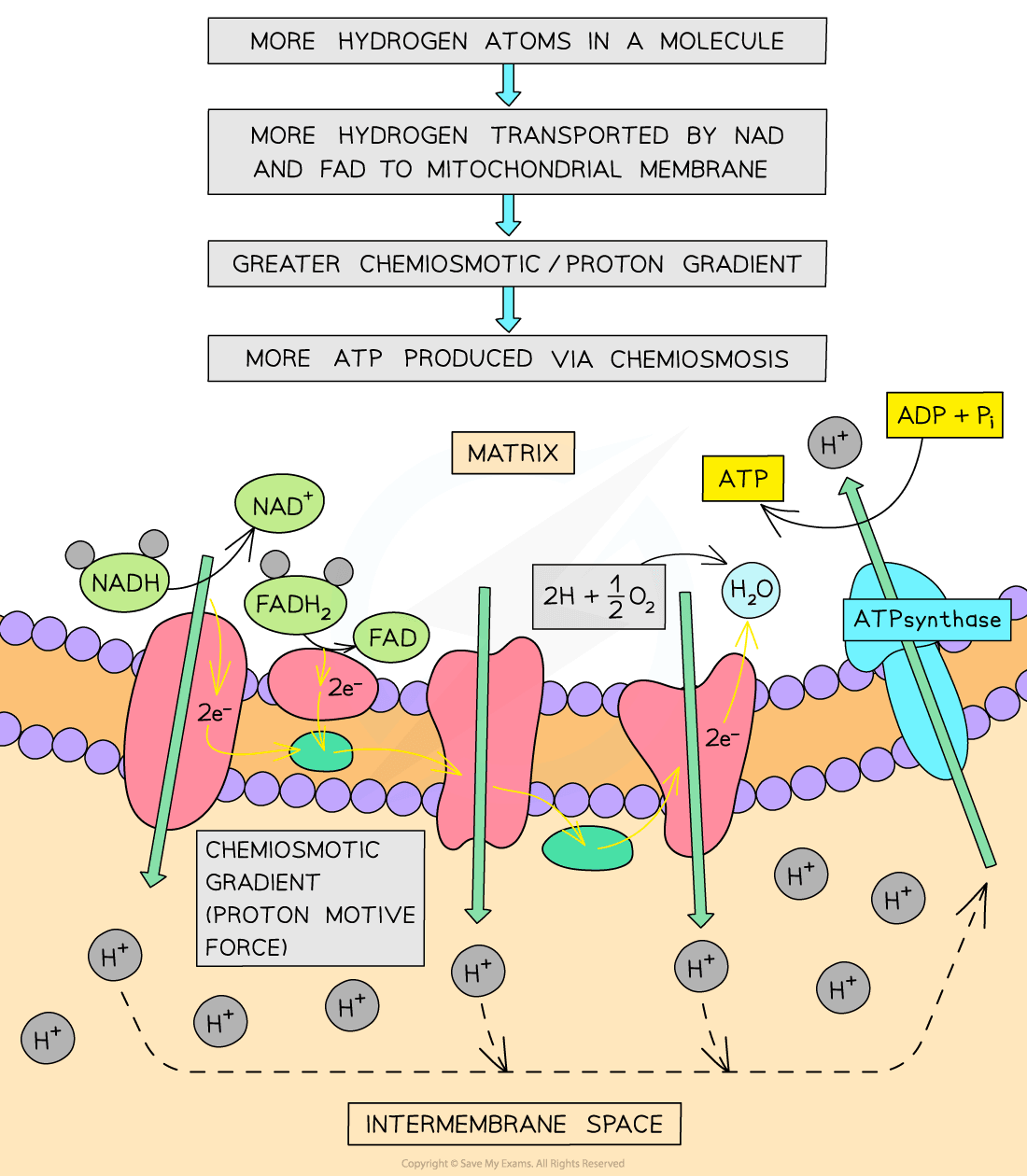Chapters
In this article, we will discuss the energy values of different respiratory substrates in detail. But before proceeding to discuss the energy values of substrates, first, let us recall the process of respiration

What is Respiration?
Respiration refers to the process that occurs in living cells. As a result of this process, energy stored in organic molecules such as glucose is released. This energy is instantly used to synthesize ATP molecules from ADP and inorganic phosphate. ATP in cells can undergo hydrolysis to release energy required to drive various biological processes.
Now, let us discuss what is the respiratory substrate.
What is a Respiratory Substrate?
A respiratory substrate refers to a molecule that can release energy to produce ATP (Adenosine Triphosphate) in a living cell.
Besides glucose, there are other respiratory substrates such as carbohydrates, lipids, and proteins. Several cells in the human body can employ a range of different respiratory substrates. For instance, brain cells only use glucose, whereas heart muscle employs fatty acids.

In the next section of the article, we will throw light on different respiratory substrates.
Different Substrates
The primary respiratory substrate for aerobic respiration is glucose. Now the question arises that why glucose is the primary respiratory substrate? Well, the answer is quite simple. It is because some cells in mammals, for instance, red blood cells and brain cells can only use glucose for respiration.
Aerobic respiration is a type of respiration that needs oxygen. If the cells use up the supply of glucose, then they continue to respire by utilizing other substrates. The other substrates can be:
- Carbohydrates
- Lipids
- Proteins
The substrates that are only respired aerobically when all the other substrates are already used up are amino acids from proteins. The main reason behind it is that they often have to perform critical functions elsewhere in the cell. Amino acids are needed to create proteins that perform functional and structural functions. The example of structural functions includes cytoskeleton and the example of functional roles includes enzymatic roles.
All the substrates release a varying amount of energy after they are broken down in the process of respiration.
In the next section, we will discuss the energy values of different substrates.
Energy Values of Substrates
The energy values of lipids, proteins, and carbohydrates are given below:
- Lipids:

- Proteins:

- Carbohydrates:

This shows that the lipids have the highest energy values, followed by proteins and carbohydrates respectively.
Why are the energy values of substrates different?
Majority of the released energy in respiration results from the oxidation of hydrogen to water. We can explain the differences in energy values of different substrates by considering their composition at the molecular level. The more hydrogen there is in the molecular structure of the substrate as compared to oxygen and carbon atoms, the greater is its energy value. The hydrogen atoms are utilized to produce ATP through the electron transport chain. That is why, to understand the differences between the energy values of various substrates, one should focus on the number of hydrogen atoms that become available after the substrate molecule is broken down.
Since fatty acids have more hydrogen atoms per one unit mass as compared to carbohydrates, therefore lipids have more energy value per unit mass. Lipids provide more than twice as much energy per gram as proteins and carbohydrates. The energy values of different substrates are expressed in  and are found by burning a known mass of the substance in oxygen in a bomb calorimeter.
and are found by burning a known mass of the substance in oxygen in a bomb calorimeter.
How Hydrogen atoms Play a Key Role in Energy Values?
The hydrogen atoms play an essential role during respiration. As the substrate molecules are broken down, the hydrogen atoms become available. Molecules that carry hydrogen are referred to as NAD and FAD. These molecules pick them up and pass them on to the inner membrane of mitochondria.
Reduced FAD and NAD liberate hydrogen atoms that divide into electrons and protons. The released protons form a proton/ chemiosmotic gradient when they are pumped across the inner membrane of mitochondria into the intermembrane space. This proton gradient is employed in chemiosmosis to generate ATP. Protons are oxidized to form water after they have flowed back into the mitochondrial matrix through ATP synthase.
This shows that the molecules which have a higher hydrogen content will have a greater proton gradient across the membrane of mitochondria that enables the formation of more ATP through chemiosmosis.

Fatty acids in lipids
Fatty acids in lipids are composed of long chains of hydrocarbon which have many hydrogen atoms. Besides a long chain of hydrocarbons, they also have a carboxylic group. Their structure has several carbon and hydrogen atoms, but very few oxygen atoms.
When the lipid breaks down the hydrogen atoms are released. The fatty acid part of lipids is very important because carbon atoms are freed in pairs as ACoA and are fed into the Krebs cycle. Lipids are used as respiratory substrates as triglycerides are hydrolyzed by lipase into fatty acids and glycerol. The glycerol can be transformed into triose phosphate and respired.
Glucose
Glucose acts as the main fuel for some cells, for instance, red blood cells and lymphocytes, and brain cells. However, few cells like liver cells also oxidize lipids and surplus amino acids.
Amino acids
The amino acids undergo deamination, and their carbon-hydrogen skeletons are transformed into pyruvate or ACoA.
In the next section of the article, we will discuss respiratory quotients in detail.
Respiratory Quotients
We can get a fair idea of the kind of respiratory substrate used by the cells in an organism by measuring the volume of oxygen it takes in and the volume of carbon dioxide it gives out. The respiratory quotient formula is given below:

The respiratory quotient values of different substrates undergoing aerobic respiration are given below:
- Carbohydrates: RQ value is 1.0
- Lipids: RQ value is 0.7
- Protein: RQ value is 0.9
The values discussed above are for aerobic respiration. If a cell or an organism respires anaerobically, then it means no oxygen is being used.













Keep on teaching us,you are excellent teachers
This is great
Thanks a lot for this book,it really helped me a lot
It’s useful to me
Thanks a lot for your Better book!
It’s a perfect article, go ahead